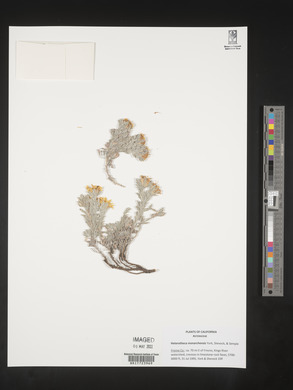Heterotheca monarchensis
|
|
|
|
Family: Asteraceae
Sequoia False Golden-Aster
|
Perennials, 9-17.5 cm; taprooted. Stems 1-25+, ascending-erect, moderately to densely hispid. Leaves: proximal cauline petiolate, blades oblanceolate to obovate, 11-17(-25) × 2-3.7(-5) mm, bases cuneate, margins ± undulate, entire, strigoso-ciliate (proximal cilia long, spreading, numerous), apices acute, faces moderately to densely hispido-strigose, sparsely stipitate-glandular; distal narrowly oblanceolate, little reduced distally. Heads 1-2(-5), borne singly or in corymbiform arrays, branches ascending. Peduncles 2-5(-10) mm, densely hispid, sparsely stipitate-glandular; bracts leaflike, sometimes surpassing involucres, those subtending heads narrower than leaves. Involucres cylindro-turbinate (campanulate upon drying), 6-7.5(-8.5) mm. Phyllaries in 3-4 series, unequal (outer lengths 1 / 4 - 1 / 2 inner), margins scarious, faces moderately strigose, sparsely stipitate-glandular. Ray florets (8-)12-16(-19); laminae 10-14 × 1-2 mm. Disc florets 30-45; corollas ± ampliate, 5-6 mm, tubes sparsely pilose distally, lobes 0.45-0.7 mm, sparsely pilose (hairs 0.2-0.6 mm). Cypselae monomorphic, obconic, somewhat compressed, 2-3 mm, ribs 9-11, shallow, faces moderately strigose; pappi off-white, outer of linear scales 0.25-0.5 mm, inner of 25-40 bristles 5-6.5 mm, longest weakly clavate. 2n = 18. Flowering (May-)Jun-Oct. Cracks, ledges, and flats on limestone, coarse sandy flats at base of cliffs, in single-leaf pine and yucca scrub communities; of conservation concern; 1000-1900 m; Calif. Heterotheca monarchensis grows only in Kings River Canyon, northeastern Fresno County. It can be superficially similar to densely hairy specimens of H. sessiliflora var. bolanderioides and to individuals of subsp. sessiliflora that are silvery white, but those usually have ovate-lanceolate distal cauline leaves, while H. monarchensis has oblanceolate ones. All three can have heads partially surrounded by distal leaves and long, subtending, leaflike bracts. Their ranges do not overlap, however. Specimens of H. monarchensis can be confused with H. villosa varieties; the latter lack the long, thin corolla hairs. The species has a small number of known populations and is therefore of conservation concern.
|


